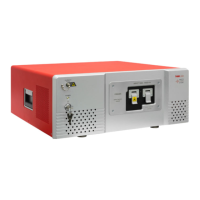Redstone™ Optical Spectrum Analyzer Chapter 8: Operation
Page 29 STN053070-D02
During the time the new spectrum/interferogram is collected, the “Single” button is changed to a “Stop” button
which if pressed will abort the current acquisition.
8.4.4. Repeated Measurements
To acquire multiple spectra/interferograms, press the button “Repeat” found under the Instrument menu. A
progress bar in the lower left corner of the window is shown and the “Repeat” button changes into a “Stop”
button, signaling that the acquisition is running.
If any problem occurs during the communication with the spectrometer, a message box will appear giving
information on what type of error has occurred.
As soon as new spectra/interferograms are available, all traces currently in “Write” status will be overwritten
with the new information. Any trace set to automatic calculation will also be updated at each acquisition.
The autogain algorithm will contiuously investigate the collected interferogram(s) and make slight adjustments
to gain and/or offset to ensure best possible settings. Whenever necessary, such as when the input source
conditions have changed considerably, the Redstone autogain algorithm will run a series of short sweeps to
determine optimal gain and offset settings. An overlay window will appear during this time advising the user to
wait for optimization to complete.
8.4.5. Automatic Setup
The automatic setup routine performs a series of measurements on the unknown light source currently being
coupled into the OSA and adjusts the measurement settings to those most suitable for that source. The settings
that will be adjusted are the resolution (Section 4.7), sensitivity (Section 4.7), apodization (Section 4.10), zero
fill factor (Section 4.11), and gain.
The routine is started by clicking on the “Auto Setup” button under the Instrument menu. It can take up to a
minute to complete, and no other measurements can be performed while it is running.
8.4.6. Averaging Spectra
Averaging multiple spectra normally reduces noise levels of the measurement. It can therefore be beneficial to
average a few spectra if the intensity of the incoming light is low.
In the Thorlabs OSA software, spectra are averaged as a rolling average, meaning that the screen will be
updated for each new spectrum that is collected and the average of all the measured spectra will be displayed
on the screen. The rolling average is calculated as
Where
is the newly displayed average,
is the previously displayed average, is the newly
acquired spectrum, is the index of a data point, is the number of data points, and is the number of spectra
to average (or, if smaller, the number of spectra averaged so far). To restart the averaging procedure, click on
the trace menu option “Clear” for the trace containing the averaged spectrum; this will reset the number of
spectra averaged so far () and the displayed average to zero.
It is possible to automatically stop the averaging when the required number of spectra have been reached by
selecting one of the options in the “Average and Stop” sub-menu on the Trace Options menu (see Section
8.7Working with Data in Traces).
8.4.7. Averaging Interferograms
The white broadband reference source in the Redstone OSA305 allows for an exact determination of the ZPD
position. This makes it possible to average interferograms, which has the same main effect as averaging
spectra.

